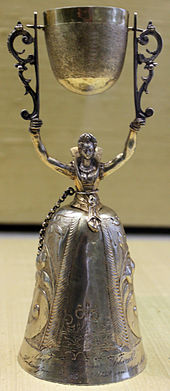Joke vessel

Virgin mug; Caspar II Beutmüller, Nuremberg; 1619; Germanic National Museum Nuremberg
A joke vessel , also a joke drinking vessel, joke glass, joke bottle, puzzle glass, puzzle vessel, puzzle jug ( Latin vexare "plague, torment"), is a vessel that is primarily used for entertainment. The handling of a joke vessel requires skill, as it is shaped in a strange way, which makes drinking or pouring difficult.
Joke vessels in the most varied of shapes were widespread and popular , especially in the Renaissance (16th century), a very good drinking time. They were not only available in a wide variety of shapes, but also made of different materials such as glass , ceramic and metal .
Some examples of shear glasses are:
- Proboscis glasses - these glasses never get empty. When drinking, the liquid runs into the hollow trunk and when the glass is put down, it runs back again.
- Goglò - these glasses consist of several hollow spheres arranged in a line. These hollow spheres are of different sizes, becoming smaller towards the top. Pouring out of such a glass requires special skill, as the liquid flows irregularly and can therefore be easily spilled. Due to its structure, the vessel also emits gurgling sounds when pouring out.
- Angster / Kuttrolf - if your neck is twisted, it is difficult to pour out. It is easy to spill liquid and amuse the table.
- Puzzle jug - only by sucking in the liquid through the nozzle (the handle and the upper edge of the vessel are hollow) can be drunk from this vessel without spilling, as the liquid runs through the holes in the upper area of the vessel when trying to pour it conventionally. In addition, drinking is often made even more difficult by a hole or several holes in the handle of the vessel, which have to be closed in order to be able to suck in the liquid.
- Virgo beaker / maiden beaker / bridal beaker - these vessels are a form of the double beaker, consisting of a smaller, movable beaker for the lady and a larger, immovable beaker for the gentleman. The man's cup represents the skirt of a lady who holds the cup for the lady with her hands over her head. If you hold the figure upside down, you can drink from both cups at the same time.
literature
- Edgar Ring (Hrsg.): Glass culture in Lower Saxony: tableware and household glass from the Middle Ages to the early modern period. Vol. 5., Husum-Verlag, Husum 2003, ISBN 3-89876-100-2 .
- Walter Spiegl: Glass. Battenberg, Munich 1979, ISBN 3-87045-155-6 .
- FA Brockhaus: The large Brockhaus compact edition. in 26 vol. Wiesbaden, 1983.
- Brockhaus encyclopedia. In 20 volumes. 17th, completely revised edition of the Großer Brockhaus. Wiesbaden, 1966.
- Meyer's encyclopedia. Meyer's Encyclopedic Lexicon in 25 volumes. 9th, completely revised edition for the 150th anniversary of the publisher. Mannheim, 1979.
- Jan Durdík: The great picture dictionary of antiques. Bertelsmann-Lexikon-Verl., Gütersloh 1968.
Web links
Commons : Joke vessels - collection of images, videos, and audio files
- Joke vessels information from the Lüneburg City Archeology Association, accessed on June 15, 2014.
- Object of the month: "Schnapsbibel" website of the Raeren Pottery Museum , accessed on June 15, 2014.
- The Bavarian National Museum is showing trophies from the Oetker Report collection in the Bayerische Staatszeitung , accessed on June 15, 2014.
- Vexier-Gefäß search result on Enzyklo.de, accessed on June 15, 2014.
- Glass exhibits from the Thuringian Museum Eisenach , accessed on June 15, 2014.
- Jungfrauenbecher Museum Pfalzgalerie Kaiserslautern , accessed on June 29, 2014
- Puzzle jug in the English Wikipedia

